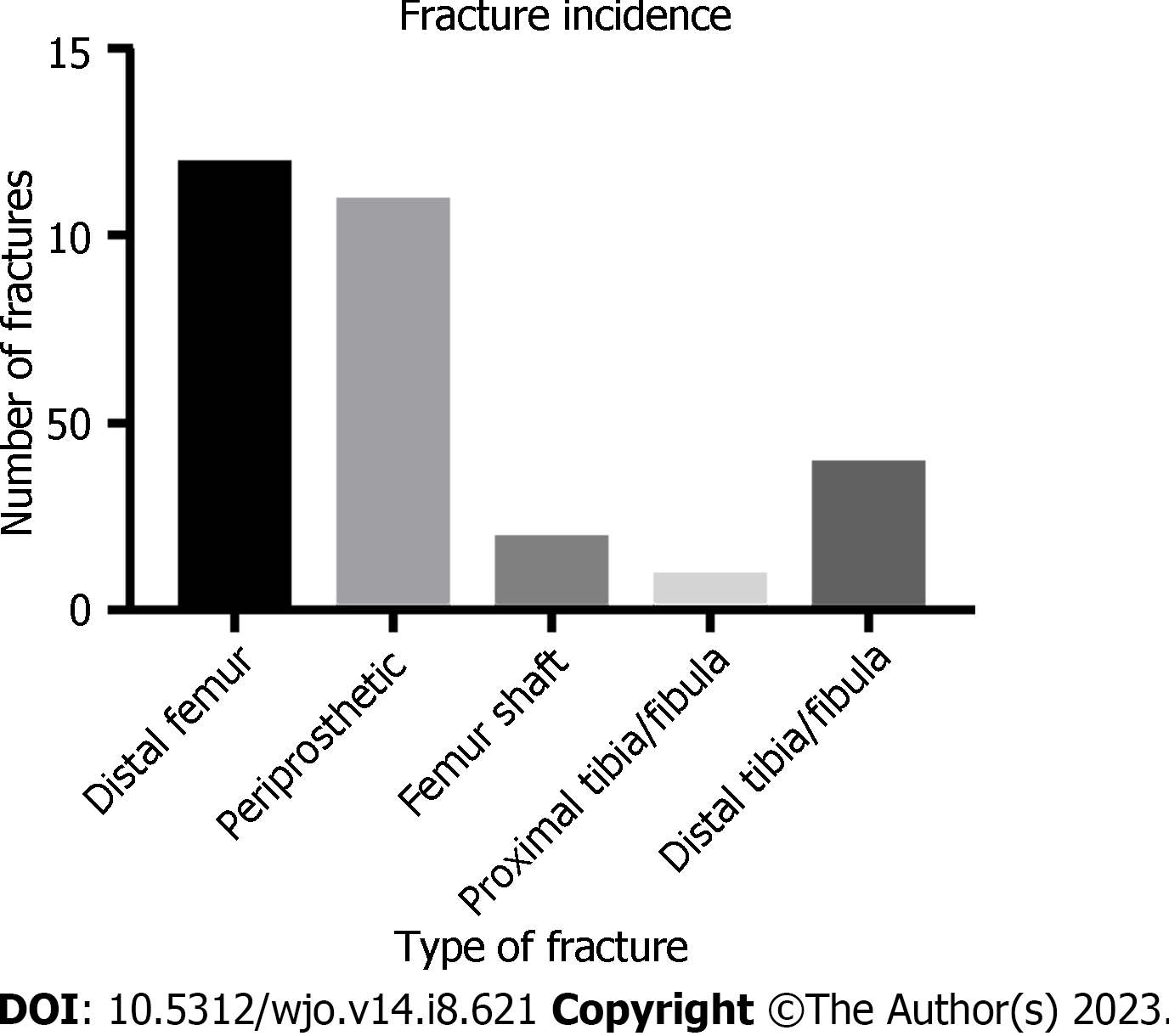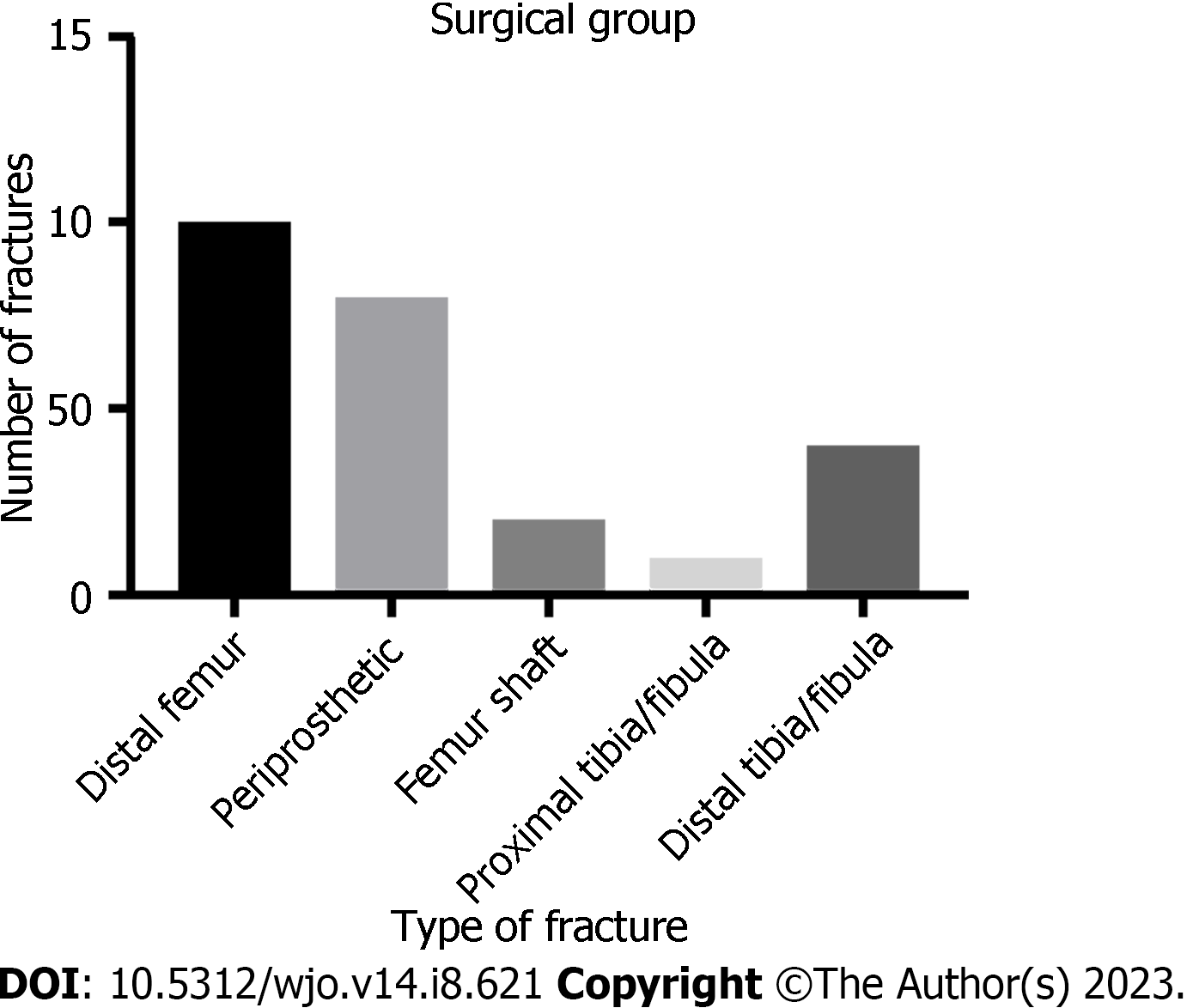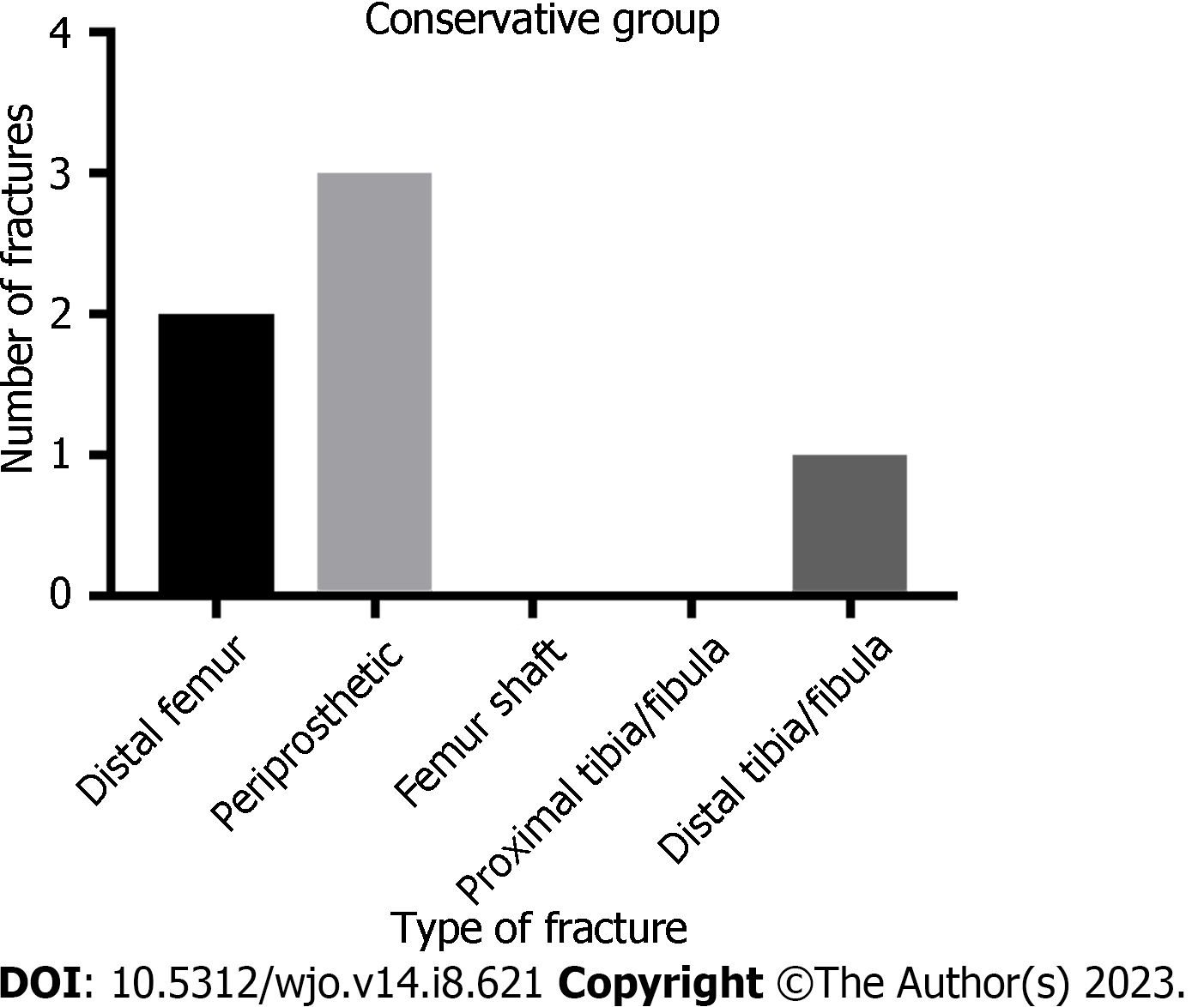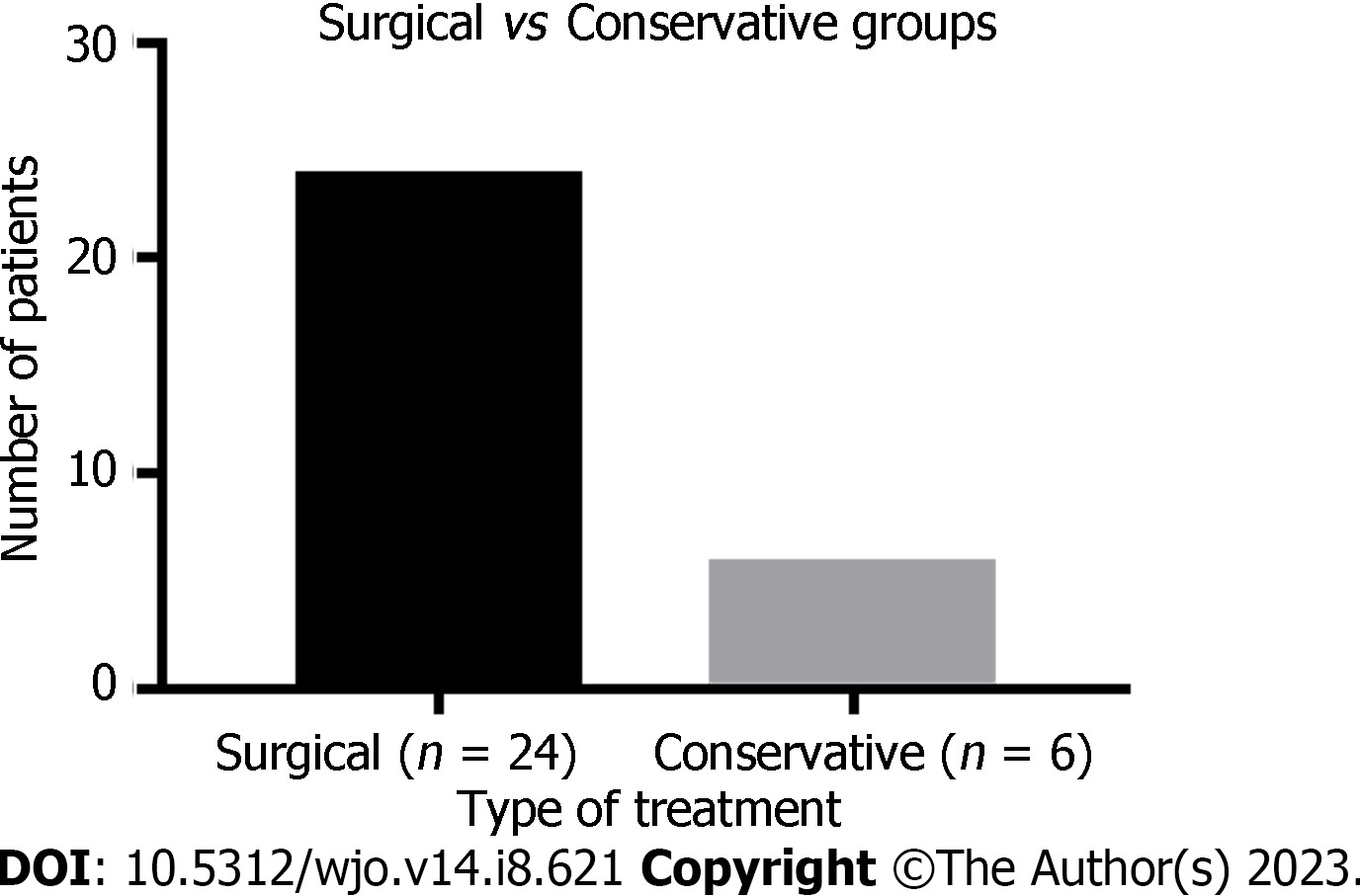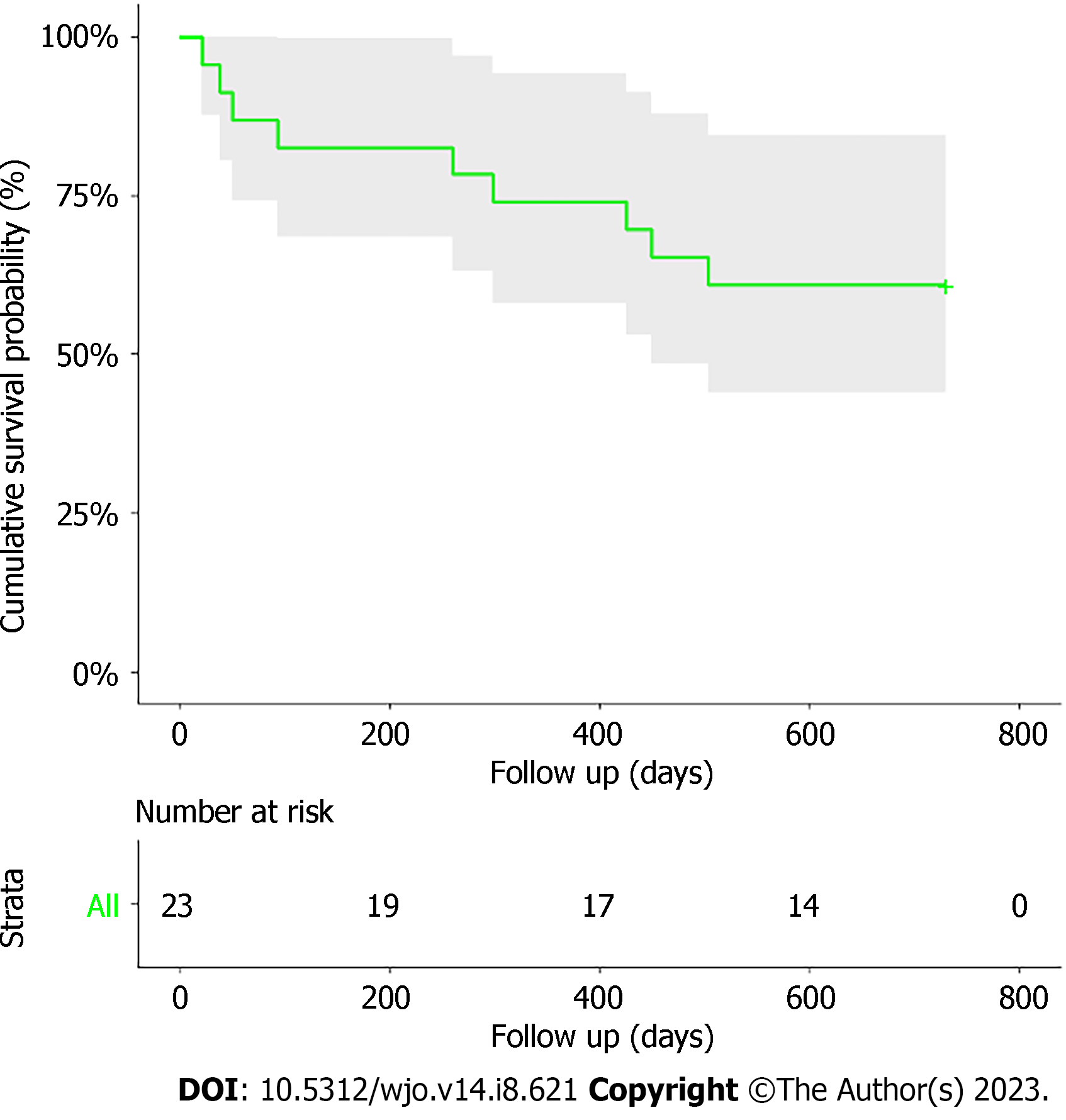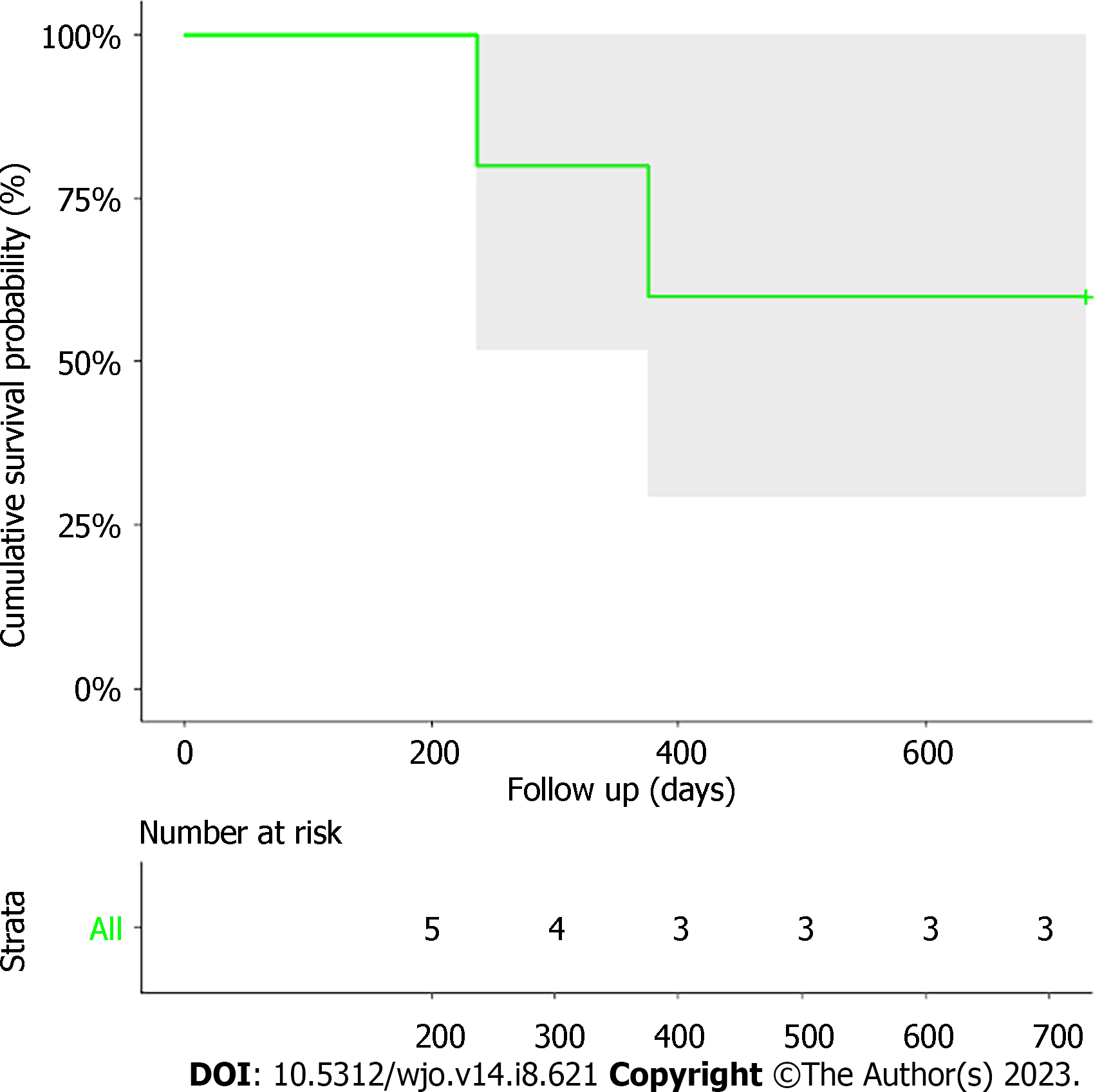Published online Aug 18, 2023. doi: 10.5312/wjo.v14.i8.621
Peer-review started: January 26, 2023
First decision: April 28, 2023
Revised: May 30, 2023
Accepted: July 27, 2023
Article in press: July 27, 2023
Published online: August 18, 2023
The United Kingdom has an aging population with nearly 1 in 5 being over the age of 65, and over 0.5 million over the age of 90. The treatment of acute fractures of the lower limb in the nonagenarian cohort of patients poses a technical challenge to orthopaedic surgeons.
To report the fracture incidence, survival outcomes of treating acute non-hip lower limb fractures in nonagenarians in Major Trauma Centre.
Thirty Lower limb long bone fractures in patients of age from 90 to 99 years were identified during 12-mo at a Level 1 trauma centre from a computerized database. A retrospective evaluation performed for fracture incidence, treatment, length of hospital duration and mortality at 30-d, 1-year and 2-year.
Thirty fractures (28 patients) were identified, twenty-four fractures were treated with surgery (mean age 93 years SD ± 2.59) and 6 managed conservatively (mean age 94 years SD ± 2.07). The mean length of the hospital stay was 18.2 d for both groups. The 30-d, 1-year and 2-year mortality risks were 1/23, 6/23 and 9/23 (4%, 26% and 39%) in the surgery group and 0/5, 1/5 and 2/5 (0%, 20% and 40%) in the conservative group, with no evidence for a difference between the two groups at any time point.
Nonagenarians in the surgical group had similar length of hospital stay and mortality risks as those treated conservatively. Patients with fewer comorbidities and admitted from their own home were offered surgery.
Core Tip: The treatment of acute lower limb fractures in nonagenarian population poses a technical challenge to orthopaedic surgeons, given the multiple co-morbidities, complex fracture pattern and poor bone quality. Nonagenarians account for 8% of all patients requiring acute fracture surgery. The main findings of this study are that surgery is more likely to be offered to those patients with fewer co-morbidities and those admitted from their own home, which indicates a higher functional status.
- Citation: Narayana Murthy S, Cheruvu MS, Siddiqui RS, Sharma N, Dass D, Ali A. Survival analysis in nonagenarian patients with non-hip lower limb fractures. World J Orthop 2023; 14(8): 621-629
- URL: https://www.wjgnet.com/2218-5836/full/v14/i8/621.htm
- DOI: https://dx.doi.org/10.5312/wjo.v14.i8.621
The treatment of fractures within the nonagenarian population (> 90 years)[1-2] poses a technical challenge to orthopaedic surgeons. This is because patients within this demographic often have multiple co-morbidities, poor bone quality and exhibit complex fracture patterns. ‘Super-elderly’ patients account for 8% of all patients requiring acute fracture surgery[2]. The World Health Organization has estimated that by 2050 the global population who are 65 years or more will be 1.5 billion and represent 16% of the world’s population[2]. This will place an immense burden on the medical resources of the National Health Service for both the acute and rehabilitative care[3].
Much of the work pertaining to fractures in the elderly has centered on hip fractures[3]. There is sparse evidence in literature looking beyond the scope of hip fractures to other lower limb trauma within this patient population. It is unknown whether this group of patients share similar outcomes to those affected by hip fractures.
The purpose of this study is to share our experience at a level 1 major trauma centre in treating long bone fractures of the lower limb in nonagenarians. We aim to report the fracture incidence, short-term outcome and the 30-d, 1-year and 2-year mortality.
This study was conducted at a level 1 major trauma centre. Interrogation of a prospectively maintained electronic admissions database was performed retrospectively. We included all patients between the ages of 90 and 99 years who were admitted with a long bone fracture of the lower limb during 2015 and 2016, including periprosthetic fractures. We excluded all soft-tissue trauma, foot and ankle fractures and all primary hip fractures.
Within our institution all patients who are fit to undergo anaesthesia are considered for surgery, depending on the fracture configuration, the aim of which is to restore the patient to their pre-injury function. Conservative (non-operative) management is reserved for patients who have undisplaced fractures and those that are unfit for surgery.
Information including patient demographics, place of residence, discharge destination, number of co-morbidities, gender, high or low mechanism of injury, fracture type and treatment, length of hospital stay and time to theatre from admission was collected from electronic patient records and picture archiving communication systems. The 30-d, 1-year and 2-year mortality was calculated for long bone fractures of the lower limb treated with or without surgery and compared using a Fisher’s exact test. Statistical analysis was performed using R (R Foundation for Statistical Computing, Vienna, Austria) and a 2-sided P value below 0.05 was assumed to denote statistical significance.
A total of 537 adult lower limb fractures were admitted over a 12-mo period within our institution, with 30 Long bone fractures of the lower limb in 28 patients between 90 and 99 years of age. Twenty-seven patients (96%) were female and 1 (4%) was male (Table 1). The mean age in the surgical group was 93 years (range 90-98 years) (SD ± 2.59) and 94 years (range 91-96 years) (SD ± 2.07) in the conservative group (Figure 1).
| Patient No. | Sex | Age, yr | Fracture type | Treatment | Number of co-morbidities | Length of hospital stay, d | Admission residence | Discharge destination | Time from admission to death, d |
| 1 | F | 98 | Periprosthetic – THR | Surgery | 3 | 22 | Home | Institution | Alive |
| 2 | F | 98 | Distal femur | Surgery | 3 | 25 | Home | Home | Alive |
| 3 | F | 96 | Periprosthetic - Thompsons | Surgery | 4 | 29 | Institutional | Dead | 29 |
| 4 | F | 96 | Distal femur | Surgery | 0 | 21 | Home | Institution | Alive |
| 5 | F | 96 | Distal femur | Surgery | 0 | 30 | Home | Home | Alive |
| 6 | F | 95 | Periprosthetic – Thompsons | Conservative | 5 | 20 | Home | Institution | Alive |
| 7 | F | 95 | Distal femur | Surgery | 3 | 8 | Home | Institution | Alive |
| 8 | F | 95 | Periprosthetic – Thompsons | Surgery | 3 | 12 | Home | Institution | Alive |
| 9 | F | 95 | Distal tibia/fibula | Conservative | 4 | 17 | Institutional | Institution | 237 |
| 10 | F | 95 | Distal femur | Surgery | 0 | 11 | Home | Institution | 300 |
| 11 | F | 94 | Distal tibia/fibula | Surgery | 0 | 18 | Home | Institution | Alive |
| 12 | F | 94 | Periprosthetic – THR | Conservative | 7 | 17 | Home | Institution | 376 |
| 13 | F | 94 | Distal femur | Surgery | 0 | 12 | Home | Institution | 429 |
| 14 | F | 94 | Distal femur | Surgery | 3 | 14 | Home | Institution | 264 |
| 15 | F | 93 | Distal tibia/fibula | Surgery | 3 | 24 | Home | Institution | Alive |
| 16 | F | 92 | Periprosthetic – Thompsons | Conservative | 2 | 24 | Institutional | Institution | Alive |
| 17 | F | 92 | Periprosthetic – THR | Surgery | 2 | 11 | Home | Institution | Alive |
| 18 | F | 92 | Distal femur | Surgery | 0 | 11 | Home | Institution | Alive |
| 19 | F | 92 | Distal femur | Surgery | 1 | 15 | Home | Institution | 39 |
| 20 | F | 92 | Distal tibia/ fibula | Surgery | 2 | 39 | Home | Institution | 50 |
| 21 | F | 91 | Distal femur- bilateral | Conservative | 2 | 13 | Home | Institution | Alive |
| 22 | F | 91 | Femoral shaft | Surgery | 3 | 16 | Home | Institution | 50 |
| 23 | F | 91 | Distal femur – Bilateral | Surgery | 3 | 28 | Home | Institution | Alive |
| 24 | F | 90 | Periprosthetic – THR | Surgery | 1 | 28 | Home | Institution | Alive |
| 25 | F | 90 | Periprosthetic – Thompsons | Surgery | 8 | 28 | Home | Institution | 505 |
| 26 | M | 90 | Distal femur | Surgery | 4 | 11 | Home | Institution | 451 |
| 27 | F | 90 | Femoral shaft | Surgery | 2 | 17 | Home | Institution | Alive |
| 28 | F | 90 | Proximal tibia/fibula | Surgery | 1 | 5 | Home | Institution | Alive |
Twenty-seven patients (96%) sustained a fracture after low energy trauma with a fall from standing height. One patient sustained bilateral distal femoral insufficiency fractures without any history of trauma. Fracture type consisted of 12 (40%) distal femoral (two patients had bilateral distal femoral fractures), 11 (37%) periprosthetic, 4 (13%) distal tibia/fibula, 2 (7%) femoral shaft and 1 (3%) proximal tibia (Figure 2).
Twenty-four fractures (80%) in 23 patients were operated on. Surgical intervention consisted of 8 (27%) undergoing open reduction and internal fixation, 5 (17%) a revision arthroplasty, 10 (33%) an intramedullary nail and 1 patient (3%) underwent a distal femoral replacement (Figures 3-5)
The mean time from admission to first surgery was 2.5 d (range 0-9 d). Definitive fracture treatment for all closed injuries was performed within 2.9 d (range 0-9 d). Four patients had open fractures, which were managed in accordance with the British Orthopedic Association Standards for Trauma and Orthopaedics[4] and treated with an initial debridement and external fixation before definitive treatment performed on a designated orthoplastic list. The mean time from admission to definitive fracture treatment in these patients was 2.5 d (range 2-3 d).
In 13 patients’ operative records the type of anesthetic used was documented; 5 patients received a general anesthetic, 5 combined with regional blocks and 3 patients had a spinal anesthetic with sedation. In all patients, a tourniquet was not used primarily due to fracture location.
Within the surgical group (n = 23): 22 patients (96%) were admitted from their own home and 1 (4%) from an institution. Physiotherapy and continuous passive motion were started on the postoperative day. On discharge only 2 patients were discharged back home; the rest were transferred to further rehabilitation institutions. It is unknown how many of these patients were subsequently able to return to their prehospital admission residence.
The mean number of co-morbidities was 2.1, time to definitive surgery 2.6 d (SD ± 2.09) and mean length of hospital stay was 18.2 d. The 30-d, 1-year and 2-year mortality in this group was 4.3%, 26% and 39% respectively.
Six fractures in 5 patients (20%) were treated conservatively. Within the conservative group (n = 5): 3 patients (60%) were admitted from their own home and 2 (40%) from an institution (Table 2). On discharge all patients were transferred to an institution. Mean number of co-morbidities was 4; mean length of hospital stay was 18.2 d. There were no deaths within 30 d; the 1-year and 2-year mortality was 20% and 40% respectively.
| No. of patients (%) | |
| Gender | |
| Male | 1 (3.6) |
| Female | 27 (96.4) |
| Fracture type | |
| Distal femur | 12 (40) |
| Periprosthetic | 11 (37) |
| Distal tibia/fibular | 4 (13) |
| Femoral shaft | 2 (7) |
| Proximal tibia/fibula | 1 (3) |
| Type of operation | |
| Open reduction internal fixation | 8 (27) |
| Revision arthroplasty | 5 (17) |
| Intramedullary nail | 10 (33) |
| Distal femoral replacement | 1 (3) |
| No operation | 6 (20) |
| Surgical (Group 1) | |
| Admitted from home | 22 (96) |
| Admitted from an institution | 1 (4) |
| Discharged home | 2 (9) |
| Discharged to an institution | 21 (91) |
| Conservative (Group 2) | |
| Admitted from home | 3 (60) |
| Admitted from an institution | 2 (40) |
| Discharged home | 0 (0) |
| Discharged to an institution | 5 (100) |
A comparison of mortality risk between the surgical and conservative groups found no evidence for a difference at any time point (P = 1 for each time point).
Long bone fractures of the lower limb in nonagenarians represents 5% of the total adult lower limb trauma admission during 1 year within our major trauma centre. Fractures within this age group nearly all result from low energy trauma and were found to be more prevalent in females. This study has found the most common lower limb fracture to occur is that of distal femoral fractures.
The most interesting finding of this study is surgically treated fractures of the lower limb is associated with an initial higher 30-d and 1-year mortality than those managed conservatively (P = 0.97, Wilcoxon-Rank), despite an increased number of comorbidities (see Figures 6 and 7). Reasons for this are likely to be multifactorial and we are unable to draw any direct conclusions due to a small cohort sample.
We are not aware of any literature which has specifically reported the mortality of fractures of the lower limb in nonagenarians. Streubel et al[5] reported a 25% 1-year mortality of patients with distal femoral fractures undergoing surgery with a mean age of 77.9 years[6]. The mortality of hip fractures has been well documented within literature. For similar age-matched groups the literature has reported 30-d and 1-year mortality between 10%-24%[5,7-9], rising to 15%-56%[10-13] in centenarians. Recently, Bolton et al[14] reported the 30-d and 1-year mortality rate in the non-agenarian hip fractures to be 12.4% and 38.1%[14].
We found surgery is more likely to be offered to patients with less comorbidity and those admitted from their own home. Postoperatively, however, all patients from both groups required admission into an institution for further rehabilitation. It is unclear how many patients were subsequently able to return to their preadmission residence. Interestingly we found there was no difference in the mean length of hospital stay between the two groups. This is similar to findings by Holton et al[15] where the mean hospital admission was longer in patients were their ankle fracture was treated with surgery (P = 0.006), compared to those offered conservative management.
Surgery in nonagenarian patients is associated with greater anaesthetic risks and technically challenging surgery because of poor bone quality and higher rates of primary fixation failure[16-17]. Despite these factors surgery is often recommended especially for those with femoral neck fractures. Surgery aims to reduce pain, assist with nursing care, and reduce the risks and sequela of complications, which can manifest from prolonged bed rest[18]. Contrary to what we have found, recent studies suggest good results may be achieved with surgery. Ng and Kwek[10] reported the operative outcomes of centenarians with hip fractures. They found centenarians had a low Charlson Comorbidity Index, postulating these patients tended to be healthier and found no deaths at 30-d with 1-year mortality of 33.3%.
The timing of surgery is also a crucial factor that must be considered in these patients. Lin et al[8] analyzed 101 patients over the age of 90 years undergoing hip fracture surgery. They found the mortality nearly doubled if surgery was not performed within 24 h of admission. Moja et al[19] performed a meta-analysis involving 191873 patients, and again demonstrated an increase in the mortality of patients if there was a delay to surgery. Within our institution we recognize this, and the authors advocate early surgery for elderly patients; however, this is not always possible due to the volume of admissions requiring treatment, the surgeon skill set and the requirement for specialized implants.
We recognize the limitations of this study, the most important of which is a small sample size for both groups. This makes it difficult to make a direct comparison between the two groups and as a result we are unable to draw any direct conclusions. Secondly, we are unable to comment on how many patients were able to return to their preadmission residence and functional status. Nevertheless, this study highlights super-elderly patients require further rehabilitation than their younger counterparts[9] and reflects an additional socioeconomic burden on limited health resources which must be addressed.
Nonagenarians have multiple co-existing medical pathologies including frailty, poor visual acuity, and polypharmacy, all of which contribute to increase the risk of falls[16]. We found 23 patients (82%) suffered a fall from standing height at home. This suggests certain patients may benefit from primary prevention strategies by identifying at risk individuals with the focus of creating a safe environment and falls prevention advice through a multidisciplinary team approach and to improve their living environment with assisted living devices.
We report the incidence and the short-term outcome of fractures of the lower limb in nonagenarians at our level 1 trauma centre. The main findings of this study are that surgery is more likely to be offered to those patients with fewer co-morbidities and those admitted from their own home, which indicates a higher functional status. Nonagenarians in the surgical group had similar length of hospital stay and mortality risks as those treated conservatively.
Nonagenarians require further rehabilitative support to gain independence and pre-injury functional level, in an institutive setting irrespective of the treatment that is instituted and arrangements for this should be sought as soon as possible. More investment, awareness and socioeconomic support will be required to keep up with current demands.
There is paucity of literature pertaining to the management and survival of non-hip fractures in the nonagenarian population. This is significant, given the rising nonagenarian population in the United Kingdom.
This study aims to analyze the prognosis/survival in a level 1 major trauma centre, in managing non-hip fractures in nonagenarian population in the United Kingdom.
To summarize the survival prognosis on nonagenarian population with non-hip fractures in a level 1 major trauma centre.
We referred to the hospital electronic database between 2015 and 2016 to include all patients with age ranging from 90 to 99 years, who had lower limb long bone fractures, including periprosthetic fractures. We excluded all hip fractures, soft tissue trauma, foot and ankle fractures. Both conservative and operative management were considered depending on the anaesthetic fitness and medical background. 30-d, 1-year and 2-year mortality were calculated for both surgical and conservative groups and compared using Fisher’s exact test.
Out of 28 patients, 23 patients (24 fractures) had surgical intervention and 5 patients (6 fractures) were for conservative treatment. The mean time from admission to definitive fracture treatment was 2.5 d (range 2-3 d). In surgical cohort, only 2 patients went home post-discharge, the rest all were transferred to rehabilitation institutions. In the conservative cohort, all patients were transferred to an institution. The 30-d, 1-year and 2- year mortality risks were 1/23, 6/23 and 9/23 (4%, 26% and 39%) in the surgery group and 0/5, 1/5 and 2/5 (0%, 20% and 40%) in the conservative group, with no evidence for a difference between the two groups at any time point.
Surgery was more likely to be offered to patients with fewer comorbidities and both conservative and surgical groups had similar length of hospital stay and mortality risks. Early planning for institutional rehabilitation and socio-economic support is utmost needed in the management of these patients.
Standard national guidelines for lower limb fractures in the nonagenarian population would streamline the diagnosis, management, and rehabilitation.
We thank Dr Jan-Herman Kuiper (Department of Biomechanics at Keele University) and Dr Siddaling Hugar (Department of Community Medicine, Mandya Institute of Medical Sciences, Karnataka, India) for their contributions in statistical analysis and amendments.
Provenance and peer review: Unsolicited article; Externally peer reviewed.
Peer-review model: Single blind
Specialty type: Orthopedics
Country/Territory of origin: United Kingdom
Peer-review report’s scientific quality classification
Grade A (Excellent): 0
Grade B (Very good): B
Grade C (Good): 0
Grade D (Fair): 0
Grade E (Poor): 0
P-Reviewer: Solarino G, Italy S-Editor: Li L L-Editor: A P-Editor: Chen YX
| 1. | Johnell O. The socioeconomic burden of fractures: today and in the 21st century. Am J Med. 1997;103:20S-25S; discussion 25S. [PubMed] [DOI] [Cited in This Article: ] |
| 2. | Clement N, Court-Brown CM. Fourscore years and ten: the fracture epidemiology of the super-elderly. Injury Extra. 2009;40:235-235. [DOI] [Cited in This Article: ] |
| 3. | Office for national statistics. Data and analysis from Census 2021. [cited 21 July 2023]. Available from: https://www.ons.gov.uk/. [Cited in This Article: ] |
| 4. | British Orthopaedic Association. The British Orthopaedic Association Surgical Standard 4 (BOAST). [cited 21 July 2023]. Available from: https://www.boa.ac.uk/standards-guidance/boasts.html. [Cited in This Article: ] |
| 5. | Streubel PN, Ricci WM, Wong A, Gardner MJ. Mortality after distal femur fractures in elderly patients. Clin Orthop Relat Res. 2011;469:1188-1196. [PubMed] [DOI] [Cited in This Article: ] |
| 6. | Hapuarachchi KS, Ahluwalia RS, Bowditch MG. Neck of femur fractures in the over 90s: a select group of patients who require prompt surgical intervention for optimal results. J Orthop Traumatol. 2014;15:13-19. [PubMed] [DOI] [Cited in This Article: ] |
| 7. | Pavic R. Court-Brown CM, Clement N. Four score years and ten; an analysis of the epidemiology of fractures in the very elderly [Injury 2009;40(October (10)):1111-4]. Injury. 2011;42:224. [PubMed] [DOI] [Cited in This Article: ] |
| 8. | Lin WT, Chao CM, Liu HC, Li YJ, Lee WJ, Lai CC. Short-term outcomes of hip fractures in patients aged 90 years old and over receiving surgical intervention. PLoS One. 2015;10:e0125496. [PubMed] [DOI] [Cited in This Article: ] |
| 9. | Anderson SA, Li X, Franklin P, Wixted JJ. Ankle fractures in the elderly: initial and long-term outcomes. Foot Ankle Int. 2008;29:1184-1188. [PubMed] [DOI] [Cited in This Article: ] |
| 10. | Ng WX, Kwek EB. Too Old for Surgery? Outcomes of Hip Fracture Surgery in Centenarians. Ann Acad Med Singap. 2017;46:115-117. [PubMed] [DOI] [Cited in This Article: ] |
| 11. | Tarity TD, Smith EB, Dolan K, Rasouli MR, Maltenfort MG. Mortality in centenarians with hip fractures. Orthopedics. 2013;36:e282-e287. [PubMed] [DOI] [Cited in This Article: ] |
| 12. | Forster MC, Calthorpe D. Mortality following surgery for proximal femoral fractures in centenarians. Injury. 2000;31:537-539. [PubMed] [DOI] [Cited in This Article: ] |
| 13. | Oliver CW, Burke C. Hip fractures in centenarians. Injury. 2004;35:1025-1030. [PubMed] [DOI] [Cited in This Article: ] |
| 14. | Bolton D, Bush C, Wallace MT. Nonagenarian hip fractures: Morbidity and mortality at a single institution. J Clin Orthop Trauma. 2021;14:69-73. [PubMed] [DOI] [Cited in This Article: ] |
| 15. | Holton J, Nandra R, Thurston D, Ali S. The management of ankle fractures in octogenarian and nonagenarians. What is the optimum mode of treatment? Int. J. Orthop. Sci. 2017;3:467-470. [DOI] [Cited in This Article: ] |
| 16. | Strauss EJ, Egol KA. The management of ankle fractures in the elderly. Injury. 2007;38 Suppl 3:S2-S9. [PubMed] [DOI] [Cited in This Article: ] |
| 17. | Roebuck J. When does old age begin?: The evolution of the English definition. J Soc Hist. 1979;12:416-428. [DOI] [Cited in This Article: ] |
| 18. | Holt G, Macdonald D, Fraser M, Reece AT. Outcome after surgery for fracture of the hip in patients aged over 95 years. J Bone Joint Surg Br. 2006;88:1060-1064. [PubMed] [DOI] [Cited in This Article: ] |
| 19. | Moja L, Piatti A, Pecoraro V, Ricci C, Virgili G, Salanti G, Germagnoli L, Liberati A, Banfi G. Timing matters in hip fracture surgery: patients operated within 48 h have better outcomes. A meta-analysis and meta-regression of over 190,000 patients. PLoS One. 2012;7:e46175. [PubMed] [DOI] [Cited in This Article: ] |










